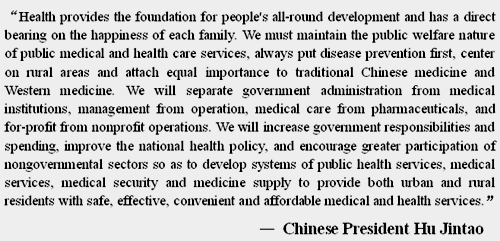"The government-led idea has won on some key issues. But parts of the idea may hurt the dynamic core of the medical system, which disappoints me to some extent," said Gu Xin, editor of the seventh medical reform scheme established by Beijing Normal University. He is also a representative who advocates the "market-led idea" and a senior analyst with the Center for Human and Economic Development Studies at Peking University. Gu spoke frankly with the China Economic News Weekly at the end of October.
In July 2005, the report titled: Chinese Medical System Reform, jointly written by Development Research Center of the State Council and the World Health Organization (WHO), pointed out that the failure of the previous medical system reforms in China had led to an obvious disparity in society. The report also suggested strengthening governmental responsibility to carry on the medical reform. Afterwards, more and more people began to support government-led medical reforms rather than the market-led reforms.
In August 2006, a coordination group for the medical reform was set up by 14 (later 16) ministries and commissions, including the National Development and Reform Commission and the Ministry of Health. This move symbolized that the medical reform had entered the draft phase.
In the beginning of 2007, the medical reform group entrusted six independent research organizations at home and abroad to draft medical reform proposals.
The former professor of the Institute of Social Development and Public Policy at Beijing Normal University Gu Xin was invited to act as editor for the seventh medical reform scheme in May 2007. "The group contacted me on May 1, and hoped that I could finalize a proposal within a month," Gu said. "The previous six schemes were mainly concerned with government-led reforms and the group wanted to hear different voices. For the first time diversity entered the drafting process."
By the end of this May, the group had selected eight plans designed by Peking University, Tsinghua University, Beijing Normal University, Renmin University, Development Research Center of the State Council, WHO, World Bank and McKinsey & Company.
This June, Tsinghua University and Harvard University jointly designed a ninth scheme for the group.
Although there are different opinions in these nine proposals, it's clear that China's medical reforms will be government-led.
In his report to the 17th National Congress of the Communist Party of China, General Secretary Hu Jintao said that China should maintain the public welfare nature of the medical and health care services. This means that the state will take over the responsibility of developing a public health care system. The report also clarified that the government's responsibility and money input would be strengthened.
From October 17 to 18, the National Development and Reform Commission held two meetings in Nanchang and Tianjin respectively to discuss medical reforms. The meetings agreed upon a new medical reform plan based on the nine proposals. The reform plan is expected to go public soon.
The new scheme has a general goal of building a basic medical service system for all Chinese rural and urban residents before 2020.
According to government-led idea, public hospitals should not be profit-oriented. Regarding finance and accounting reforms within the hospitals, all public monies should be handed over to the health administrative department. This department would be responsible for all financial allocations.
"This means that the health administrative department will completely control the public hospitals as if it was under the planned economy system. If the power were over centralized, new corruption would emerge," Gu Xin explained.
The government has also recognized some suggestions of the market-led idea.
The seventh scheme edited by Gu Xin suggested that in the 2006-10 period medical insurance would be expanded to include more people, including working, nonworking and retired city residents and rural residents. Commercial medical insurance would be set up to provide medical services that aren't provided by public medical insurance.
"We have reached consensus that the government should provide medical subsidies to the public," said Gu
In the beginning of November, insiders of the medicine field told the China Economic News Weekly that the nine proposals were being discussed hotly. It was not clear whether the draft would be made public before the end of this year.
"How to cope with the investment and allocation of power and responsibility is the key issue to China's medical reforms," Gu said.
(China.org.cn by Li Xiaohua November 14, 2007)


